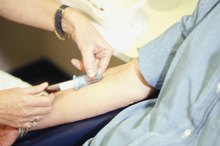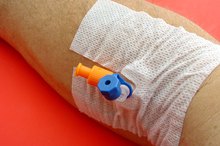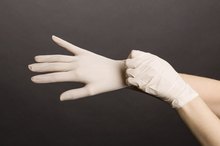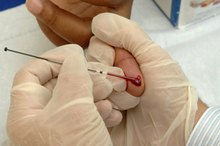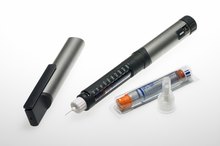Types of Syringes & Needles
Giving medications by injection requires the use of the right syringe, the right needle and the right part of the body. Syringes are also used to remove blood from the body during blood donation, for blood samples and to transfuse blood into a patient.
About Syringes
Syringes are made up of a round cylindrical barrel, a close-fitting plunger and a tip where the hub of a needle is attached. They come in a number of sizes, ranging from .5 ml to 60 ml.
A 1- to 3-ml syringe is normally adequate for injections given into tissues under the skin, also called subcutaneous injections, or injections into muscle, also known as intramuscular injections. Larger syringes are used to add medication to intravenous lines and irrigate wounds.
- Syringes are made up of a round cylindrical barrel, a close-fitting plunger and a tip where the hub of a needle is attached.
- A 1- to 3-ml syringe is normally adequate for injections given into tissues under the skin, also called subcutaneous injections, or injections into muscle, also known as intramuscular injections.
Classification
Types of IV Catheters
Learn More
Syringes are generally classified as Luer-Lok or non-Luer-Lok syringes. This classification is based on the type of syringe tip. Luer-Lok syringes have tips that require needles that can be twisted and locked into place. This design prevents the needle from accidentally slipping off the syringe. Non-Luer-Lok syringes have tips that require needles that can be pressed on to the tip of the syringe without being twisted into place.
- Syringes are generally classified as Luer-Lok or non-Luer-Lok syringes.
- Non-Luer-Lok syringes have tips that require needles that can be pressed on to the tip of the syringe without being twisted into place.
Insulin Syringe
Insulin syringes are small in size, they hold between 0.3 and 1 ml of medication 1. These needles are not calibrated in milliliters, they are calibrated in units.
Most insulin syringes are calibrated up to 100 units. Insulin syringes are designed for self-injection and are used to give subcutaneous injections.
- Insulin syringes are small in size, they hold between 0.3 and 1 ml of medication 1.
- Most insulin syringes are calibrated up to 100 units.
Tuberculin Syringe
Venipuncture Methods
Learn More
Tuberculin syringes are used for tuberculosis testing. The fluid they contain is injected right into the skin. This syringe is small and is calibrated in milliliters. It has a long, thin barrel with a preattached needle. The tuberculin syringe can hold up to 1 ml of fluid. Even though this syringe is small, it cannot be used to give insulin.
- Tuberculin syringes are used for tuberculosis testing.
- This syringe is small and is calibrated in milliliters.
About Needles
Most needles are made of stainless steel. The needle is hollow with a hole in the middle and has three parts: the hub, which fits on to the tip of the syringe; the shaft, which is the long length of the needle; and the bevel, which is the slanted tip of the needle.
**The bevel creates a narrow slit or hole in a persons skin through which the fluid in the syringe is injected into a person.
** This slit closes once the needle is removed from the person's skin so there is no leakage of medication or blood. Long-beveled tips are sharper and narrower, which reduces discomfort when it pierces the skin.
- Most needles are made of stainless steel.
- This slit closes once the needle is removed from the person's skin so there is no leakage of medication or blood.
Types Of Needles
Needles are differentiated based on their length and diameter. The length of needles range from between 1/2-inch to 3 inches. **The diameter of a needle is measured in gauges.
** A 25-gauge needle has a smaller diameter than a 19-gauge needle. As the needle gauge gets bigger, the needle's diameter gets smaller.
Two different needles may have the same length and have different gauge sizes. Needle gauges range from between 7 gauge being the largest to 33 gauge the smallest. **Gauge selection is made based on the thickness of a medication to be given.
If the medication is thick, a needle with a small gauge and big diameter would be the needle of choice. ** Intramuscular medications are given with long needles, while subcutaneous medications are given with shorter needles.
- Needles are differentiated based on their length and diameter.
- The diameter of a needle is measured in gauges.
Related Articles
References
- "Fundamentals of Nursing" ; Patricia A. Potter FAAN and Anne Griffin Perry FAAN; 2009
- State of New Hampshire State of New Hampshire Department of Health and Human Services Division of Community-based Care Services Division of Community-based Care Services Bureau of Developmental Services. Medication Administration Curriculum.; Section II. 2012. dhhs.nh.gov
- Guy JS. Pharmacology for the Prehospital Professional. Second. Jones & Bartlett Learning; 2019:82.
- WHO Best Practices for Injections and Related Procedures Toolkit. Geneva: World Health Organization; 2010 Mar. 2, Best practices for injection. Available from: https://www.ncbi.nlm.nih.gov/books/NBK138495/
- Gill HS, Prausnitz MR. Does Needle Size Matter? J Diabetes Sci Technol. 2007;1(5):725-729. doi:10.1177/193229680700100517
- Weiss M, Hug MI, Neff T, Fischer J. Syringe size and flow rate affect drug delivery from syringe pumps. Can J Anesth. 2000;47(10):1031-1035. doi:10.1007/BF03024878
- Hamborsky J, Kroger A, Wolfe S, eds. Centers for Disease Control and Prevention. Epidemiology and Prevention of Vaccine-Preventable Diseases. Chapter 6: Vaccine Administration. 13th edition. Washington, DC; Public Health Foundation, 2015.
- Salari M, Estaji Z, Akrami R, Rad M. Comparison of skin traction, pressure, and rapid muscle release with conventional method on intramuscular injection pain: A randomized clinical trial. J Educ Health Promot. 2018;7:172. Published 2018 Dec 28. doi:10.4103/jehp.jehp_216_18
- Centers for Disease Control and Prevention. Vaccine Recommendations and Guidelines of the ACIP: Vaccine Administration. Updated June 21, 2019.
- Doyle, G.R., McCutcheon, J.A. (2015). Clinical Procedures for Safer Patient Care. Chapter 7.3: Intradermal and Subcutaneous Injections. Victoria, BC: BCcampus.
- Doyle, G.R., McCutcheon, J.A. (2015). Clinical Procedures for Safer Patient Care. Chapter 7.4: Intramuscular Injections. Victoria, BC: BCcampus.
- Grissinger M. Reducing errors with injectable medications: unlabeled syringes are surprisingly common. P T. 2010;35(8):428–451.
- Shemesh E,D'Urso C,Knight C et al. Food-Allergic Adolescents at Risk for Anaphylaxis: A Randomized Controlled Study of SupervisedInjectionto Improve Comfort with EpinephrineSelf-Injection. J Allergy Clin Immunol Pract.2017 Mar - Apr;5(2):391-397.e4. doi:10.1016/j.jaip.2016.12.016. Epub 2017 Jan 20.
- World Health Organization. WHO Best Practices for Injections and Related Procedures Toolkit-Best practices for injection. Geneva. March 2010.
Writer Bio
Ngozi Oguejiofo has been writing on a freelance basis since 2009 and most of her writings are focused on health. She is currently a registered nurse. She is interested in teaching, and writes articles focused on student nurses for various online publications.

